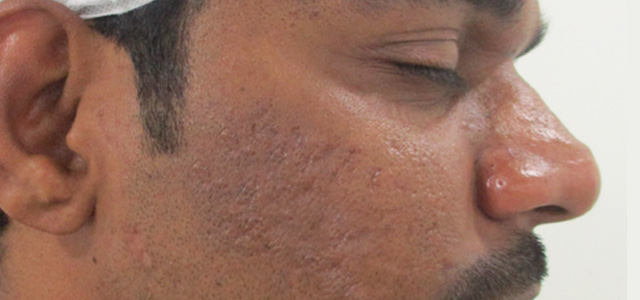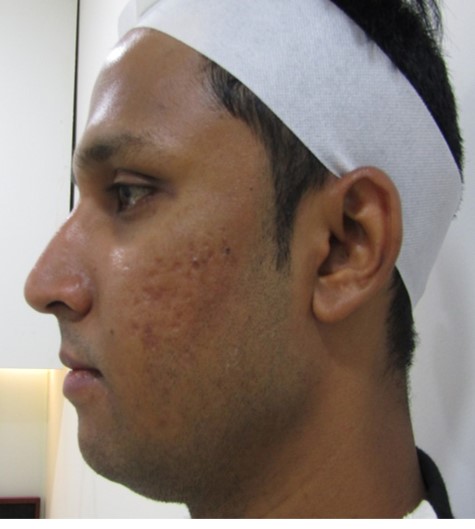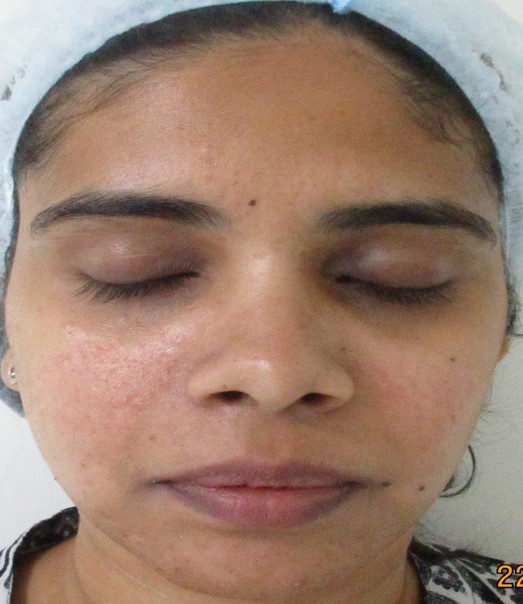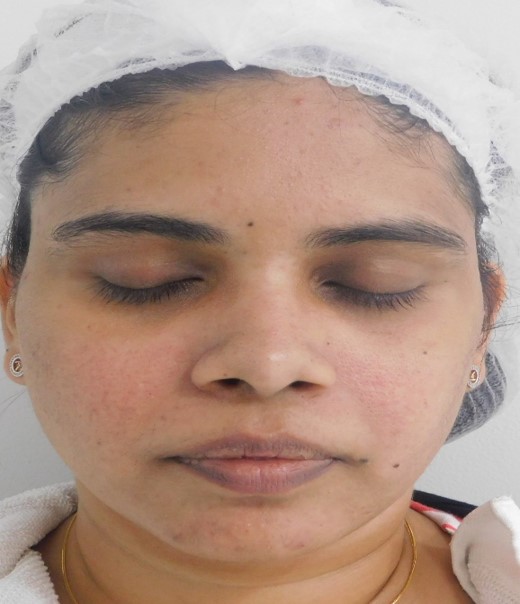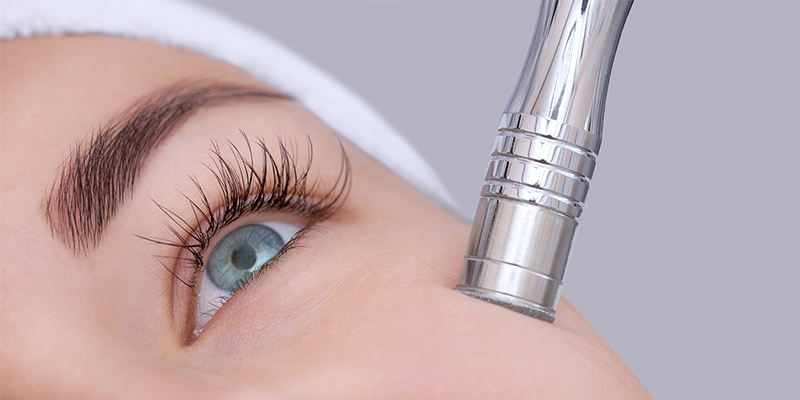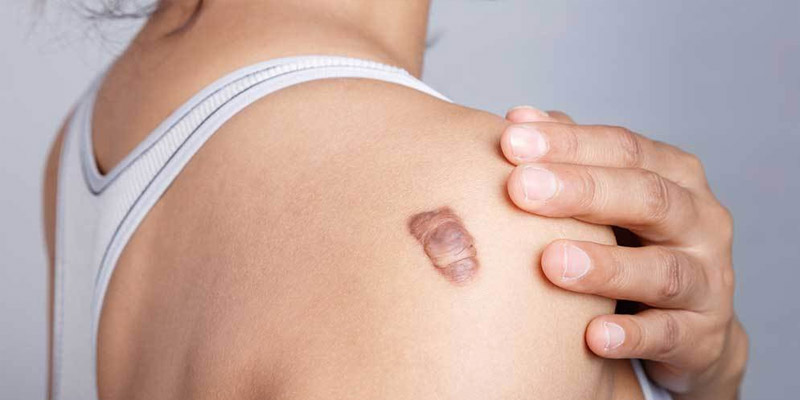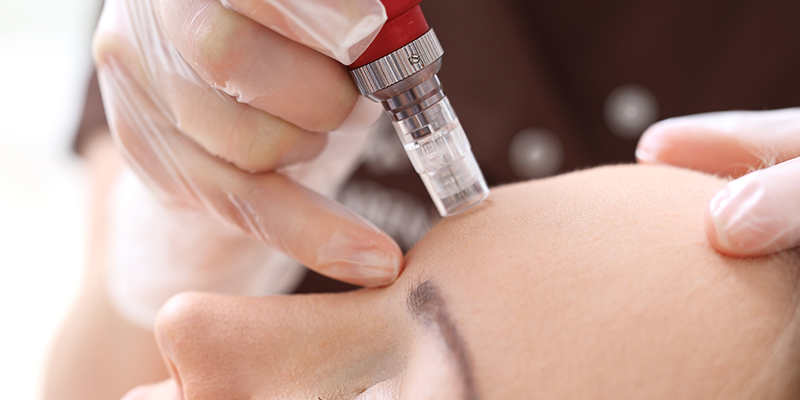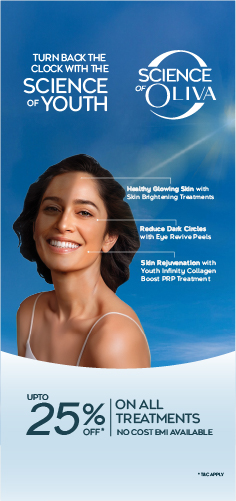Laser Skin Resurfacing Cost, Benefits, Procedure, Before & After Results
Laser skin resurfacing is one of the most effective laser treatments for the face that helps to treat various skin concerns, such as hyperpigmentation, acne scars, uneven texture and more. With the help of this advanced laser skin treatment, the damaged layer of skin is removed in a controlled and precise manner. One can expect long-term improvement in tone and texture of the skin.
If you are wondering about side effects of laser treatment for face, then you must keep reading! This article covers everything you need to know about laser skin resurfacing treatment.
Table Of Content

What Is Laser Skin Resurfacing? How Does It Work?
Laser skin resurfacing is one of the best medico-aesthetic treatments, popular around the world for its efficacy and results. The treatment harnesses the power of concentrated lasers to precisely target various skin concerns, including sunburn, dark spots, acne scars, wrinkles, fine lines and so on.[1] This treatment aims to rejuvenate the skin texture and improve complexion. The laser beams help remove the damaged outer layers of the target area by stimulating new collagen production. This increased collagen tightens the skin, making it smooth and even-toned.
Experts use two main types of lasers for the treatment:
- Ablative laser, which vaporises the skin and stimulates collagen production in the skin.
- A non-ablative laser, which heats the underlying dermis and encourages collagen production without removing the top damaged layer of skin.
Concerns Treated By Laser Skin Resurfacing:
The laser skin treatment is an ideal procedure for treating the following skin concerns:
Ageing signs, such as wrinkles and fine lines:
The laser skin resurfacing treatment works on ageing concerns in the following manner.
- The laser beam targets the top layer of the skin, which is saggy or has fine lines and wrinkles. The treatment gently peels off the top layer of the skin.
- The laser beam penetrates the deeper layers and stimulates collagen and elastin production in those layers.
- The treatment tightens the deeper layers, resulting in radiant skin while reducing ageing signs.
Dark spots or uneven skin tone:
The treatment can conceal dark spots and pigmentation signs resulting in even toned skin. Here is how:
- The laser skin resurfacing treatment targets the surface layer of the skin which has uneven tone or darker spots.
- Once the upper damaged layer has been exfoliated, it reveals the brighter and clearer deeper layer of the skin.
Acne Scar:
Laser treatments work on acne scars in two ways:
Exfoliation:
The laser beam exfoliates the top layer of damaged skin where the scar is present. Upon exfoliation, the treatment reveals smoother skin underneath, making the scar less visible.
Collagen Boost:
The heat from the laser penetrates the deeper layers of skin, stimulating collagen production in the targeted area. Collagen is a protein responsible for boosting new cell production while reducing the appearance of raised scars and wrinkles.
Injury Marks:
Laser skin resurfacing treatment can fade away or reduce the appearance of stubborn injury marks by exfoliating the top damaged layer of the skin. The collagen boosting property of the treatment promotes healthy skin cells to grow, leading to reduction of the injury marks.
Sun Damage:
This treatment can help regain the natural colour of the skin by removing tan due to excessive sun exposure. The laser treatment exfoliates the tanned skin revealing clearer skin.
Who Is An Ideal Candidate?
Laser resurfacing works on almost all skin types. Anyone suffering from the concerns mentioned above and over 18 years of age can opt for this procedure. However, it is not advisable for pregnant and lactating women. Clients under specific medication or those who are prone to hypertrophic scars or keloids may not be suitable candidates for this procedure.
Benefits Of Laser Skin Resurfacing:
Here are the top seven benefits of laser skin resurfacing treatment:
-
Safety:
The laser skin resurfacing treatment is an absolute safe treatment. It has been widely accepted and used as a cosmetic solution for the majority of skin concerns related to tone and texture.
-
Stimulates Collagen Production:
The laser skin resurfacing treatment triggers collagen production in the treated area. This offers natural skin improvement results.
-
No Downtime:
The treatment has nil downtime. One can resume regular activities after the treatment is over.
-
Non-Invasive:
The laser skin resurfacing treatment doesn’t involve any cuts or stitches. It is a non-invasive treatment that can be performed during lunch-hour.
-
Quick Treatment:
One need not spend more than 90 minutes for the treatment.
-
Long-lasting Results:
Compared to any other traditional skin treatments, laser skin resurfacing will offer lasting results. You can further retain the smoothness of the skin with follow-up sessions.
-
No Side Effects:
There are no major side effects from the treatment to worry about, as long as an experienced dermatologist is involved in the process. One may experience transient redness and swelling in the treated area and you can manage it with topical creams and cold compress as prescribed in the post-care instructions.
Body Areas That Laser Skin Resurfacing Can Treat
Dermatologists can perform laser skin resurfacing on the following body areas:
-
Face:
To treat acne scars, chicken-pox scars, post-traumatic scars, burn scars, surgical scars, hyperpigmentation, fine lines and wrinkles etc.
-
Neck, Arms, And Chest:
To treat marks secondary to acne, chickenpox, age spots, uneven skin tone due to suntan etc.
Laser Skin Resurfacing Cost In India
The laser skin resurfacing cost in India ranges from Rs. 10,000 to Rs. 16,000 per session. This cost may vary based on several factors. (See the next section.)
Take a look at the table below which depicts the cost of laser skin resurfacing for each concern:
| Concern | Minimum Cost per Session (INR) | Maximum Cost per Session (INR) |
| Wrinkles | ₹ 10,000 | ₹ 40,000 |
| Fine Lines | ₹ 7,000 | ₹ 40,000 |
| Dark Spots | ₹ 5,000 | ₹ 50,000 |
| Acne Scars | ₹ 5,000 | ₹ 60,000 |
Here is a detailed cost table, which depicts the cost of laser skin resurfacing depending on the type of laser being used:
| Laser Type | Minimum Cost per Session (INR) | Maximum Cost per Session (INR) |
| Ablative CO2 Laser | ₹ 30,000 | ₹ 80,000 |
| Erbium YAG Laser (ablative) | ₹ 10,000 | ₹ 60,000 |
| Fractional CO2 Laser (ablative) | ₹ 20,000 | ₹ 50,000 |
| Non-ablative Fractional Laser | ₹ 15,000 | ₹ 30,000 |
| Pulsed Dye Laser (vascular concerns) | ₹ 7,000 | ₹ 20,000 |
DISCLAIMER:
Please note that the prices mentioned are indicative and may vary depending on the specific treatment, choice of technology, and underlying skin or hair conditions. Prices are also subject to change based on ongoing promotions or offers at the clinic. For an accurate estimate, please consult with our dermatologist.
Factors Affecting The Cost Of Laser Skin Resurfacing Treatment:
The cost of laser skin treatment can be different in various cities and clinics. There are various factors responsible for this variation, such as:
The cost of laser skin treatment can be different in various cities and clinics. There are various factors responsible for this variation, such as:
- The Type Of Concern: Depending on one’s concerns, the number of treatment sessions and type of laser used can vary. Therefore, the treatment cost also varies.
- Severity Of The Concern: The more severe the skin condition, the more sessions are required, which increases the cost of the treatment.
- Size Of The Target Area: Smaller target areas, such as chin or upper lip, do not take up that much time as compared to larger body areas, such as back. So, the size of target area will also impact the treatment cost.
- Number Of Sessions Required: This is self-explanatory: fewer sessions will cost less.
- The Type Of Laser Used: The type of laser being used; ablative or non-ablative will also have a role in determining the cost of the treatment.
- Experience Of The Dermatologist: Dermatologist with more experience will charge higher than inexperienced or those who just started their practice.
- Clinic’s Reputation: Reputed clinics and renowned brands charge more for the treatment than others.
- Clinic Facilities: Clinics that offer various, high-class facilities charge higher.
- Geographic Location: Clinics in metro cities charge hefty as clinic expenses are also higher in these locations.
- Treatment Customisation: Some clinics offer extended packages, including follow up sessions. Those clinics accommodate everything and charge accordingly.
Dermatologists use different laser technologies to perform laser skin resurfacing treatment, including the following:
Ablative Lasers:
The heat from the laser targets the outer skin layer in a controlled manner, creating micro-injuries. It breaks down old collagen, making way for healthy collagen production and new skin with more compact and organised fibres. Since the treatment works by gently heating the dermis; it is safe for treating sensitive areas of the face. It can help deliver smoother and firmer skin and reduce the visibility of scars. Treatments using this laser involve an extended downtime and a higher risk of scarring, secondary infection and pigmentation if one does not follow proper post-care guidelines. Types of ablative lasers include carbon dioxide (CO2) laser and the erbium laser.[2]
Non-ablative Lasers:
These are less invasive when compared to ablative lasers and do not cause open wounds. Non-ablative lasers work gently to treat the dermis without affecting the skin’s surface. The controlled heat affects only the targeted tissue and triggers collagen production. The production of new collagen helps reduce the visibility of unwanted scars and causes skin tightening and rejuvenation.
Treatments that use this type of laser are painless with low downtime and are comparatively safer for darker skin tones. They work best to treat mild to moderate scars, and reduce post-inflammatory hyperpigmentation and deliver blemish-free skin.
Pixel Fractional Resurfacing:
Fractional laser resurfacing is the most preferred technique to treat scars with precision. The laser energy splits into tiny beams to treat the affected area of the skin in a more focused way.[3] Unlike ablative lasers, which vaporise the skin’s top layer in a confluent manner, these lasers selectively treat the target area by creating evenly-spaced microscopic perforations, leaving intervening columns of healthy skin. This process facilitates faster healing and significantly reduces the downtime and risk of complications. It is safe for all skin types and works best to treat old blemishes, scars, ageing issues, and enlarged pores.
Laser Skin Resurfacing Treatment Procedure
Here are the following steps you can expect while undergoing laser skin resurfacing treatment:
Before The Procedure:
- The dermatologist will examine your skin thoroughly during the consultation to assess the severity of your skin concern and customise a treatment plan that may include laser skin resurfacing as a standalone or combination treatment.
- Your dermatologist will share pre-care instructions to help you prepare or prime your skin before the laser resurfacing session to enhance its healing and reduce the risk of any possible side effects. You need to follow pre-care instructions for a few weeks before the actual procedure
During The Procedure
- On the day of treatment, a qualified therapist will cleanse your skin to remove any traces of excess oil, dirt and makeup.
- She will then apply a numbing cream to the target area to ensure that the treatment is painless and comfortable.
- The doctor will perform a patch test by passing a laser beam on a smaller area before starting the procedure.
- The dermatologist will then customise the parameters like the fluency of the laser and the number of passes required based on your skin type and severity of the concern.
- A therapist will apply soothing cream and sunscreen after the doctor completes the session.
- Your doctor will provide post-care support to help you enjoy sustainable results.
Laser Skin Resurfacing Before And After Results
Check out the before and after images that show the visible improvement in the skin texture and firmness after laser skin resurfacing treatment.
How Should I Take Care Of My Skin After Laser Resurfacing?
Here is a list of aftercare you should follow for the best laser resurfacing results:
- After the treatment, skin may feel itchy, swollen and stingy. Avoid scratching or pricking the skin after the treatment. This may cause scarring and may trigger skin infection.
- Cleanse the treated area as prescribed by the dermatologist.
- Use extra pillows for comfort and care till the swelling subsides.
- Apply a cold compress for about 15 minutes every 2-3 hours in initial 48 hours of treatment.
- Apply the prescribed ointment until the skin heals.
- Avoid facial or any parlour service at the treated area for about six weeks.
- Avoid smoking, as it may slow down skin healing.
- Once skin shows signs of healing, apply broad-spectrum sunscreen to protect a new layer of resurfaced skin.
- Moisturise.
- Avoid aggressive rubbing of the treated area.
Laser Treatment For Face Side Effects:
Some of the minor side effects from the treatment can be: (Remember that not everyone experiences side effects)
-
Redness:
One may experience mild redness on the treated area, which is harmless and will subside on its own.
-
Itching:
You may feel slight stinging and itchiness, which also subsides in a few hours on its own.
-
Swelling:
The skin on the treated area may appear swollen or inflated. The swelling will reduce 2 days after the treatment.
Crusting:
As the treatment involves removal of the top layer of skin, one may experience crusty skin before the new skin properly develops.
-
Minor infections:
The treatment can destroy the hair follicles and expose a risk of infection if not cared for properly. One must keep the treated area clean and moisturised to prevent dryness or the risk of infections.
Some rare, major side effects include:
-
Blisters:
If the practitioner is inexperienced, reckless and uses a low standard device, it can cause burns or blisters on the target area.
-
Scarring:
Improper care after the treatment can lead to scarring. Follow all aftercare instructions to avoid this side effect.
Major Infection:
These are very rare, but can occur if the practitioner isn’t prepared enough or careful enough during or after the treatment.
-
Eye Damage:
The treatment can trigger an eye condition called ectropion, where the lower eyelid turns outward, away from the eye. This is a rare side effect; however, anyone who experiences this should immediately report to the dermatologist.
NOTE:
Listing these side effects is not to create fear but to be aware and cautious while choosing your dermatologist. Making the right choice for your laser skin resurfacing treatment can significantly reduce the risk of major side effects.
The following section of this article can help you make an informed choice of a dermatologist.
How To Choose The Best Laser Skin Resurfacing Treatment?
Here are a few things you need to keep in mind while opting for laser skin resurfacing treatment:
- It is imperative that you choose a clinic that has experienced dermatologists and certified therapists who follow rigorously tested protocols while performing advanced dermatological procedures. Do not compromise on the reputation of a clinic as any laxity can cause irreparable damage to your skin.
- Ensure that the clinic uses the latest, US FDA-approved technology with proven safety and efficacy.
- Discuss your medical history in detail with your dermatologist before choosing the treatment.
- Take into consideration the number of sessions required, costs, and side effects (if any) to make an informed decision.
- Religiously follow the pre and post-treatment guidelines by your doctor to minimise the risk of side effects and complications.
- Your dermatologist may conduct a patch test before actual procedure to choose appropriate parameters for your skin.
- He/she might prescribe some medical treatment along with this aesthetic procedure to achieve optimal results.
FAQs On Laser Skin Resurfacing Treatment
Laser resurfacing works by creating controlled micro-injuries in scarred tissue. This stimulates collagen production and results in smoother, scar-free skin.
Laser skin resurfacing is generally safe when performed by a qualified dermatologist. However, there are risks of complications such as infection, scarring, or changes in skin tone. Adequate pre- and post-care and completing the sessions recommended by your dermatologist are a must to minimise these side effects.
Laser skin resurfacing is a versatile and effective treatment for addressing various skin concerns, including signs of ageing, sun damage, acne scars, and uneven skin tone. It is crucial to consult with a qualified dermatologist to determine the most suitable type of laser resurfacing for individual skin types and concerns.
Anyone over 18 can undergo laser skin resurfacing treatment if they have acne scars after consulting a dermatologist. Those who are pregnant or nursing their infants should skip this treatment for the time being.
Both chemical peels and laser resurfacing can effectively improve skin texture and appearance, but the choice depends on factors such as skin type and the type and severity of your acne scars. Laser resurfacing can target deeper scars that adversely affect the skin texture, while chemical peels may be better for pigmented acne marks.
Laser resurfacing can effectively reduce the appearance of acne scars by stimulating collagen production and improving the skin texture. However, the results depend on factors such as the type and severity of the scars.
Redness and swelling are common side effects after laser resurfacing and typically subside within a few hours to days. Following post-care instructions can expedite your skin recovery.
Laser resurfacing is worth it for individuals seeking to improve their skin texture, tone and appearance, especially if they have wrinkles, sun-damaged skin, or acne scars. However, it’s essential to have realistic expectations and discuss potential risks and benefits with a qualified dermatologist.
Laser skin resurfacing provides long-lasting results. Over time, factors such as acne, ageing and sun exposure can affect the skin’s appearance, necessitating maintenance treatments to sustain the results.
Laser resurfacing treatment offers lasting results and is suitable for all skin types, compared to IPL. Though laser skin resurfacing is slightly expensive than IPL, it is safer and requires fewer sessions to see results.
The number of laser skin resurfacing sessions you require depends on factors like the type of concern, its severity, the area to be treated and the type of laser used.
Yes, you can expect your face to peel after the treatment as it involves the removal of top damaged layer of the skin. As the skin heals, it may develop crusts before revealing clear, renewed skin.
The treated scars fade away. If you experience new acne breakouts, they may result in scars.






